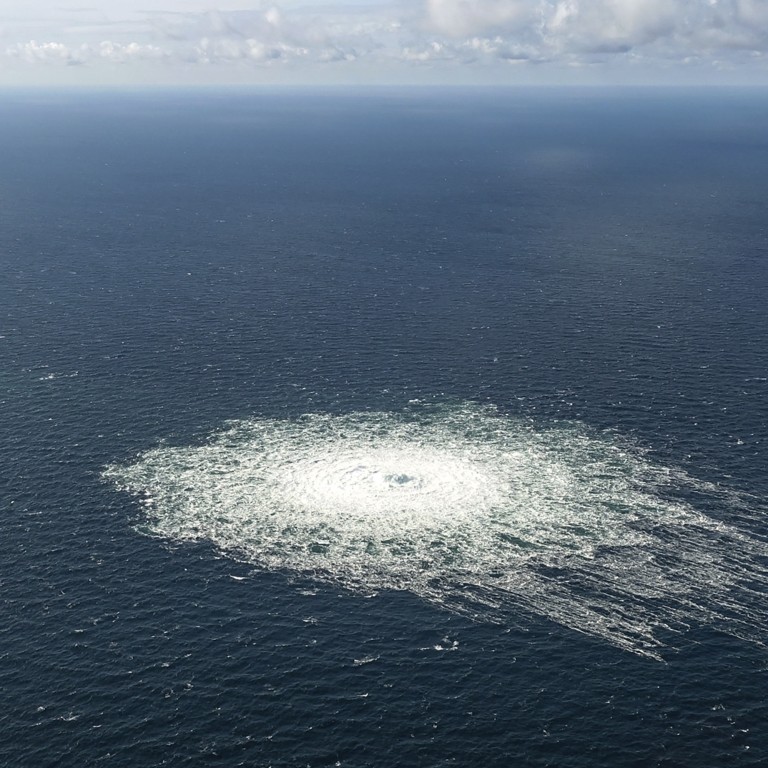
Fourth leak detected after ‘sabotage’ of Nord Stream pipelines in Baltic Sea
- Sweden’s coastguard discovered another gas leak on the Nord Stream pipelines damaged earlier this week
- The European Union suspects sabotage was behind the gas leaks on the subsea Russian pipelines to Europe
“There are two leaks on the Swedish side and two leaks on the Danish side,” a Swedish Coast Guard official said, after three leaks were confirmed earlier this week on the Nord Stream pipelines in the Baltic Sea.
The official added that the two leaks on the Swedish side are “close to each other”.
The Swedish coastguard could not immediately say why the latest leak only appeared days after the initial breaches.
Media reported that the latest leak was detected at the Nord Stream 2 pipeline, but the coastguard did not confirm this.
Sweden had previously reported a leak on the Nord Stream 1 pipeline northeast of Bornholm, while Denmark has confirmed a leak on Nord Stream 2 to the southeast of the island, and another to the northeast above Nord Stream 1.
EU suspects sabotage likely in leaking Russian gas pipelines
The vast leaks cause significant bubbling at the surface of the sea several hundred metres wide, making it impossible to immediately inspect the structures.
Suspicions of sabotage emerged after the leaks were detected.
Swedish intelligence said it was opening an investigation into the massive leaks, branding them “aggravated sabotage”, hours after the EU called the damage a “deliberate act”.
Russia’s FSB security service said it had launched an “international terrorism” investigation, the Russian prosecutor’s office announced, citing “intentional actions” to damage the pipelines.
Amid the claims and counter claims, the UN Security Council said it will meet Friday – at Russia’s request – to discuss the leaks.
The question of who is responsible has prompted high-level finger-pointing, with Moscow charging the United States had already said Nord Stream 2 was “finished” if Russia invaded Ukraine.
President Joe “Biden is obliged to answer the question of whether the US carried out its threat,” foreign ministry spokeswoman Maria Zakharova said on social media on Wednesday.
Washington dismissed the suggestion, with a spokeswoman for the National Security Council saying: “We all know Russia has a long history of spreading disinformation and is doing it again here”.
On Thursday, Russia’s foreign ministry said that leaks occurred in a zone controlled by US intelligence services, the RIA Novosti news agency reported.
Among Western allies, suspicion for the leaks has focused on Russia, which has cut gas supplies to Europe in retaliation for severe Western sanctions over the war in Ukraine.
They “are not a coincidence”, EU foreign policy chief Josep Borrell stated. “All available information indicates those leaks are the result of a deliberate act.”
He warned: “Any deliberate disruption of European energy infrastructure is utterly unacceptable and will be met with a robust and united response”.

EU chiefs Ursula von der Leyen and Charles Michel have also blamed the Nord Stream leaks on sabotage, as have leaders of several European countries.
Michel tweeted that they “appear to be an attempt to further destabilise energy supply to EU”.
He added: “Those responsible will be held fully accountable and made to pay”.
A source within the British defence force said that the Nord Stream 1 and 2 pipelines were likely attacked with remotely-detonated explosives.
Speaking to Sky News, the unnamed source said the leak in both pipelines was likely the result of a pre-planned attack.
The source said that mines could have been planted along the underwater pipelines using a long line, by dropping them from a boat, or with a drone, months or years before the attack.
China, Russia seek diversification from US dollar with gas deal, say experts
Citing two unnamed Western intelligence officials, CNN reported that European security officials knew of Russian Navy support ships being spotted near the leaks in the Nord Stream pipelines.
One of the intelligence officials told CNN that Russian submarines were also seen near the area last week.
According to climate groups, Nord Stream 1 and 2 contained some 350,000 tonnes of natural gas – methane and Greenpeace estimates the leaks could have the effect of releasing almost 30 million tonnes of CO2, or more than two-thirds of Denmark’s annual emissions.
Following Europe’s sabotage allegations, fossil fuel-rich Norway – which has overtaken Russia as the biggest supplier of gas to Europe – boosted security at its oil and installations in response.
Built in parallel to the Nord Stream 1 pipeline, Nord Stream 2 was intended to double the capacity for Russian gas imports to Germany.
But Berlin blocked newly completed Nord Stream 2 in the days before the war.
Germany, which has been highly dependent on imports of fossil fuels from Russia to meet its energy needs, has since come under acute stress as Moscow’s supplies dwindle.
Additional reporting by Business Insider and Reuters

.png?itok=arIb17P0)